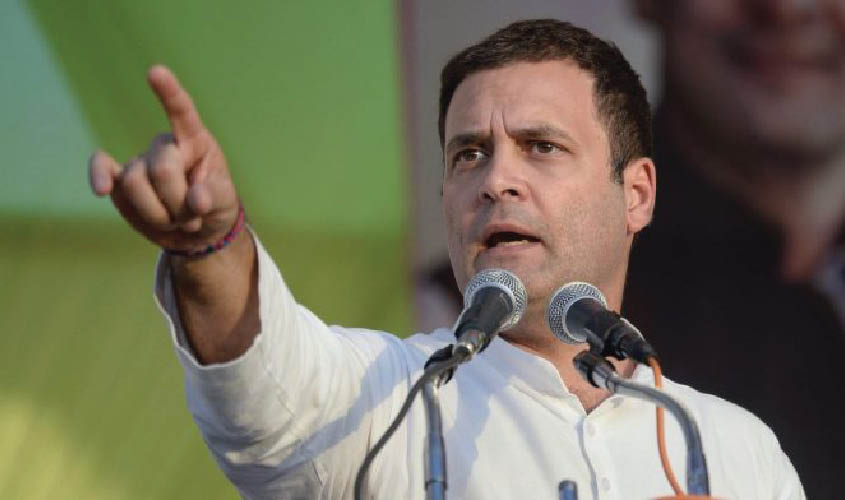Congress president Rahul Gandhi, despite fighting against communists at Wayanad in Kerala, is keen to appease the Left. This is an ominous portent for the grand old party and the country, for both have suffered because of Congress-Left dalliances in the last half a century.
Speaking at Alappuzha on 16 April, he said that “the Left has never done anything like what the RSS is doing in the country. The Left has never tried to control the institutions of the country. They never tried to question the Constitution of the country.” What he said is factually incorrect: the Left has done everything to not only control institutions but also “wreck” them, mostly from within. As for the Constitution, it was under its influence that the words “socialist” and “secular” were inserted into the Preamble. He seems to have said this because he wants to keep his options open in the post-poll scenario.
The Congress’ honeymoon with the Left under Indira Gandhi, which began in the late 1960s, proved to be such a bane for economic policy that the deleterious effects are still felt. The mother of myriad scams, bank nationalisation—which Indira Gandhi carried out to please the commies and fellow travellers in 1969—has cost the taxpayer in recent years lakhs of crores that he had to shell out for a series of recapitalisations.
The honeymoon has cost the entire economy dearly. Thankfully, there have been long periods of estrangement between the two, generally in the 1980s and the 1990s. It reflected in economic growth rates. In the 1970s, when the Leftist influence was at its peak, the economy expanded at a rate around 3.4%, the so-called Hindu rate of growth. In 1980, when Indira Gandhi came back with full majority, she didn’t need much Left support; consequently, its influence faded a bit. Her son and successor, Rajiv Gandhi, a pilot, was never enamoured with the Left, so he had little regard for the voodoo economics of the Left. The consequences were pleasant: the economy grew at a rate of 5.8%.
And then there were reforms in 1991, ushering in unprecedented prosperity and lifting millions of people from poverty. During 1991-98, the economy grew at 6.1%, after which there was some decline because of the indirect effects of the East Asian crisis and post-Pokhran sanctions.
The most important factor, however, was the reduced influence and then almost absence of the Left from the power structure. Ironically, though, it was also during the 1990s that a couple of communist leaders became important members of the Union Cabinet; but this had little impact on the continuation of liberalisation.
The champions of free market were ecstatic. Gurcharan Das called the days when the economy was opened up as the Golden Summer of 1991 in his book India Unbound. The first 13 years of liberalisation were glorious—that is, from the perspective of reformers. Every government since 1991 had furthered the cause of reforms. “Reforms are irreversible”—this was one of the most spoken sentences at the conferences organised by business chambers.
And then the sun set.
When Sonia Gandhi took charge of the nation with the help of the Left in 2004, the creatures everybody thought had become extinct came back—not with a whimper but a bang. Lutyens’ Delhi became Jurassic Park, with red dinosaurs trampling everything they suspected of being related to reforms, be it fiscal prudence or privatisation. Remember A.B. Bardhan, the general secretary of the Communist Party of India, who famously said “Disinvestment bhaad mein jaaye (Let disinvestment go to hell)”? It triggered, among other things, a bloodbath on Dalal Street.
While the Congress-Left alliance lasted four years, the damage it caused is yet to be taken care of. Reds and fellow-travellers laid down landmines in the economy that keep tripping reformers till date. The pre-1991 ancien régime experienced a resurrection in every possible manner—in phraseology (terms like “profiteering” were revived), legislation (national rural guarantee law, the Forest Rights Act, etc.), anti-business attitudes (resistance to every big project), in almost everything.
In short, whenever the Left has gained ascendance, and it has been only during the Congress regimes, the economy has suffered grievously. To be sure, it’s not just the Left’s influence on economic policy. Lal salaam theories like “majority communalism is more dangerous than minority communalism” result in the downplaying of the threat of Islamic terror.
As revealed by Wikileaks, Rahul said to former US ambassador to India, Timothy Roemer in December 2010 that “the bigger threat [to India] may be the growth of radicalized Hindu groups, which create religious tensions and political confrontations with the Muslim community”. Even if the beast called Hindu terror does exist, it is certainly not a threat bigger than jihad.
Equally dangerous is Rahul’s and his party colleagues’ proximity with the tukde-tukde gang. In their bid to keep Left radicals and jihad-compliant activists, many of whom harbour traitorous proclivities, the Congress top brass seems to have lost a sense of proportion.
As it is, the Congress is infested with pinkish intellectuals like Mani Shankar Aiyar. Against this backdrop, Rahul’s Left turn could have very unpleasant consequences not just for the country but also his party. The Congress-Left alliance would be a Faustian covenant, which is better avoided.

